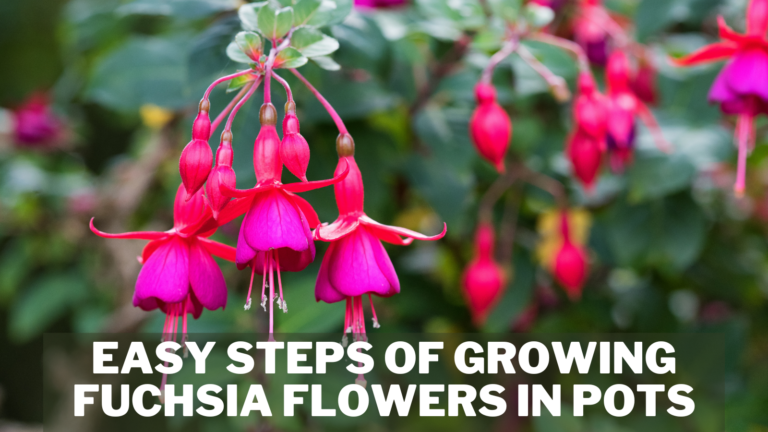Best Steps To Grow Saint John’s Wort In Containers
Best Steps To Grow Saint John's Wort In Containers
The unusual herb St. John's Wort is one that even non-herbalists can grow at home, and it has much to offer.
This woody perennial, which reaches a compact height of 24 inches, will establish itself as a consistent source of colour in your garden from late spring through the summer.
St. John's Wort (Hypericum Perforatum), which produces a profusion of yellow flowers, fills the air with a beautiful fragrance that fills the senses of everyone who passes by.
This blog post will assist you in perfectly growing Saint John's Wort in containers.
What Is St. John’s Wort?
The Hypericaceae family of herbaceous perennial flowering plants includes St. John's wort (Hypericum spp.).
More than 700 species exist in this family, also called the St. John's wort family. It acquired its common name because of its connection to St. John the Baptist.
Unexpectedly, the best time to harvest this plant is on June 24th, the official day of that saint (or thereabouts, depending on your location).
It was connected to the sun and utilized in fertility and divination rituals in pre-Christian Celtic culture.
It is also referred to as “Klamath weed” in North America. This is because it drastically outgrew its native habitat in the Klamath River region of California early in the 20th century.
It had taken over and covered two million acres by the middle of the 1940s, spreading across 30 northern California counties.
Although this family contains over a thousand medicinal species, Hypericum perforatum is the most widely used. Additionally, it is the one that pharmaceutical preparations use the most.
Grow Saint John's Wort In Containers
1. Container Requirements To Grow St. John's Wort
St. John's wort can adjust to various pot sizes and thrive when confined in a small space.
Plant large-sized St. John's wort in a container of at least 3 gallons (11 L) in volume and 12 inches (30 cm) deep.
St. John's wort, on the other hand, will flourish in smaller containers but won't grow as big.
Although St. John's wort rarely grows taller than 3 feet (91 cm), it has a robust, deep taproot.
However, the seeds must be planted directly in the ground; they cannot be transplanted or grown in containers. This taproot will grow deeply (unless you have a bottomless container).
If you have the space, you can direct sow indoors in the final container size rather than starting in a seed tray or small pot and growing it in a larger pot.
However, this isn't necessary since St. John's wort is a hardy plant accustomed to growing in challenging conditions.
2. Soil To Grow Saint John's Wort In Containers
The standard St. John's wort can thrive in various soil conditions. Except for heavy clay, it prefers sandy loam with good drainage.
The ideal loam has a pH range of 5.5–7.0 and is slightly acidic. Dry soil and drought conditions can cause the roots to rot.
3. Sunlight Requirements To Grow St. John's Wort
St. John's Wort plants grow best when they receive an uninterrupted 8 hours of full sun each day when grown outdoors in a herb garden.
Although their growth is slightly slowed in the partial shade, they will still develop, especially if shaded during the hottest, brightest part of the day.
They thrive when grown close to a south or west-facing window that gets a lot of direct sunlight indoors.
St. John's wort is frequently said not to grow well indoors, which is accurate if plants don't get enough sunlight.
Invest in additional growing light for your indoor plants if your home doesn't get enough natural light through the windows.
Plants are kept from growing tall and lanky due to a lack of sunlight by using a growing light.
4. Temperature Requirements To Grow St. John's Wort
St. John's wort is a plant that grows in temperate regions worldwide but is originally from North America, Europe, and Asia.
It grows indoors between 65°F and 70°F, close to most homes' typical temperature.
Keep plants away from drafts from leaky windows or doors that are frequently opened and closed, and register vents from the furnace or air conditioner during the winter and summer.
These erratic temperatures stress plants internally and have an impact on their growth.
5. Water Requirements And Hardiness Of St. John's Wort Plants
The Hypericum genus contains numerous plant species. The ideal temperature range for plants is 20 to 26 °C, though they can survive in environments as cold as -10 °C.
They prefer warm, humid environments. They tolerate drought and need little water but can't stand flooded ground. Do not water the soil so frequently that it becomes soggy.
6. Pruning Of St. John's Wort
To ensure optimal blooming, prune your Saint John's wort at the end of winter or the start of spring before the first buds emerge.
It's unnecessary to prune every year, but if you do it every two to three years, your Saint John's wort will maintain a compact bearing.
A single branch will occasionally experience a growth spurt that causes it to become long and leggy.
If it's not growing as you want, don't be afraid to cut it shorter; this will encourage branching and help the shrub become denser, leading to more lush blooming later.
Feel free to prune the shrub back to the ground if the foliage has dried out and appears sparse and bare. New shoots will begin to emerge from the stump.
When done appropriately, St. John's wort pruning can be quite severe (early spring).
7. Fertilizer Requirements For St. John's Wort
Common St. John's wort doesn't need a lot of fertilization. After the initial planting, additional fertilization is typically not required unless clear signs of slow growth emerge.
If that occurs, apply some low-concentration balanced compound fertilizer (10-10-10 NPK ratio).
8. Propagation Of St. John's Wort
You can grow standard St. John's wort by sowing seeds, cutting off branches, or dividing plants.
Put seeds in a bed of sand to plant them yourself. The seeds should sprout in 10°C to 12°C of heat after being dusted with a thin layer of soil and receiving one watering.
Continue to moisten the potting soil. When seedlings reach a height of 5 to 10 cm, transplant them.
At the end of the summer, a soft-branch cottage is typically used to propagate St. John's worts with dense branches.
Pick a few strong, flexible branches that have recently sprouted. Keep at least two entire leaves on each branch by cutting branches 10 to 15 cm long from the tip.
Keep half of the cut branches above ground as you plant them in the ground. Keep the environment and the soil moist.
Transplant seedlings into pots when they are 20 cm tall. To move outside, seedlings must reach a height of 70 cm or wait until the end of the following summer.
9. Pests & Diseases Of St. John's Wort
Powdery Mildew
The plant's leaves are primarily impacted by powdery mildew. The leaves initially develop a sticky white powder, which darkens to black or brown as the leaves wilt and turn yellow.
Improve ventilation and light duration, keep them from being planted too close together, and apply treatments to prevent or treat powdery mildew.
Cut the infected leaves and branches off the plant, along with the older leaves at the bottom, and burn them when they become infected.
Root Rot
Root rot is a fungus that slowly robs a plant's roots of its capacity to absorb water and nutrients, leading to its eventual death.
The primary signs are withered, yellowing leaves. Applying fungicides to the soil will treat root rot.
It is best to use thoroughly disinfected soil and add enough compost to prevent root rot before planting because the microorganisms in manure can eradicate the pathogens.
9. Harvest St. John's Wort
St. John's wort blooms in the Northern Hemisphere around the summer solstice in June, but you can also find flowering plants in July and August.
It blooms in the fall in the Southern Hemisphere, typically between October and January.
Pick your St. John's Wort when the brilliant yellow flowers bloom to maximize the plant's therapeutic benefits.
The best time to harvest is in the middle to late afternoon when the flowers open up.
Additionally, the morning dew will be dried off by the sun, making it simpler to cut flowers or stems.
Harvesting dry St. John's Wort is preferred if you intend to dry the plant. The plant will be more difficult to hang and dry, and it will take much longer to dry completely.
In fields, St. John's wort grows untamed. The shrubby plant's bright yellow flowers and tiny leaves with tiny black dots are usually enough to recognize it.
Unfortunately, not long after you pick those lovely yellow flowers, they begin to droop.
Before using them, you should remove the flowers or leaves by hand. They are simple to remove from the stems.
Again, if the flowers are open and dry, it will be simpler for you to do this.
The thick stems are useless for most purposes, but if you need to harvest a large quantity quickly, you can safely cut the plant's top 2 to 3 inches (5.1 to 7.6 cm).
You won't kill the plant, so don't worry. After that, you can remove the stem from the flowers and leaves.
Once the leaves and flowers have been removed, discard the stems. Keep the leaves and flowers on the stems if you intend to dry the plant.
Usages Of St. John’s Wort
This plant, known scientifically as Hypericum perforatum and more commonly called St John's Wort, has been the subject of centuries-old common use for mood-related disorders.
The herb is one of the most common options for mild to moderate depression and anxiety.
St. John`s Wort, through neurotransmitter effect, is linked to serotonin-dopamine-norepinephrine levels improvement in one's brain and, therefore, affects the positive feeling mood regulation of the recipient.
One of the most powerful natural anti-depressants, some have used Kratom to substitute pharmaceutical medications.
Although famous for its mood-enhancing effects, St. John's Wort is also used to treat internal and external infections…
Its leaves are applied as a poultice, stimulating wound healing, especially for eczema and minor burns.
Even though honey's anti-inflammatory properties could be beneficial in reducing redness and swelling, new evidence suggests that it might also combat the herpes simplex virus.
Hot Flashes & Moodiness Hot flashes and mood swings are also common symptoms of menopause, which double as two more conditions that are often treated with St John's Wort.
One study suggested it can blunt these symptoms, possibly affecting neurotransmitters. St. John's WortHeals and Calms the Nervous system, so You can also Take it for Sleep / Insomnia
If you add treating symptoms of perimenopause mild-moderate depression, all come to work in the same way.
Of course. St. John Wort is good for you anyway, so do take it if also using a photo-sensitizing product like the one we sell at the Tea Spot, but pay attention!
It also interferes with some medications (e.g. blood thinners, antidepressants and contraceptive pills), which decreases their effectiveness.
So, whenever you use St. John's Wort, talk with your healthcare provider — especially if using other medications to boot!!!
St. John's Wort Oil
Ingredients For 1 l Oil
- Fresh St. John's wort (flowers and leaves): 300 grams
- Vegetable oil: 1 L
Method
- Dry the flowers in the oven for 1½ to 2 hours at 70°C (about 150°F).
- Fill a clean glass bottle with the dried flowers.
- After adding the oil, tightly cap the bottle.
- For 4-6 weeks, cover and depart in a warm, sunny location (window). Shake ferociously all through.
- The oil will eventually take on a lovely reddish hue.
- When the oil is prepared, pour it into a clean bottle after passing it through a fine sieve. Give a label and a tight seal. Keep in an excellent, dark location. The oil has a four-month shelf life.
St. John’s Wort Salve
Ingredients
- St. John’s Wort infused oil: 4 oz
- Organic cayenne powder: 2 teaspoons
- Beeswax pastilles: 2 tablespoons
Method
- Combine the oil and cayenne powder in a double boiler and barely heat. Don't let the oil bubble as you allow it to cool; reheat.
- Remove from heat and let sit for 24 hours to infuse.
- To remove extra powder, strain oil through cheesecloth the following day.
- Beeswax and herbal oil should be combined in a double boiler and gently warmed over low heat until the beeswax melts.
- Pour immediately into glass jars or tins, then let them cool completely.
- Salve storage should take place somewhere cool where the salve will stay semi-solid.
St. John's Wort Tea
Ingredients For 1 Cup
- Dried St. John's wort (flowers and leaves): 2 teaspoons
- Honey or maple syrup (to taste)
Method
- Place the St. John's wort in a cup with a tea infuser.
- Pour 150 ml (or 5 oz) of boiling water over it and steep for 10 minutes.
- Remove the tea infuser, add honey to taste for sweetness, and serve.
- St. John's wort tea has various medicinal benefits, including an anti-inflammatory effect.
Benefits Of St. John’s Wort
The flowers are used to create teas, pills, and liquid extracts. The well-liked herbal therapy is frequently used to lessen the effects of depression. People have used St. John's wort for centuries.
- According to a Cochrane systematic review, major depression can be successfully treated with St. John's wort.
- St. John's wort reduced mild to moderate depressive symptoms more than a placebo and similarly to prescription antidepressants, according to Trusted Source's analysis of 35 studies.
- St. John's wort had similar effects on mild to moderate depression as antidepressants, according to Trusted Source's analysis of 27 studies.
- Compared to antidepressants, fewer people stopped taking St. John's wort, according to those researchers. According to a dependable source, St. John's wort can treat wounds, bruises, burns, and sores.
- The FDA, however, has not authorized the drug to treat depression or any other medical condition. The FDA categorizes St. John's wort as a dietary supplement, not a drug. As a result, neither its effectiveness nor safety are tested by the agency.
- A certified naturopathic doctor named Jeremy Wolf explained that St. John's wort causes various bodily reactions.
- He says, “it is a potent antidepressant and may elevate mood in people with mild to moderate depression.” He points out that people with severe depression shouldn't take St. John's wort.
- According to Wolf, St. John's wort also has potent antiviral properties that may aid in healing and repairing wounds. He stated that the herb was not a quick fix. It might take weeks or months before you see any results.
Conclusion
When given enough sunlight and drained soil, St. John's wort thrives in containers and grows well indoors.
Growing it in a pot prevents it from encroaching on your flowerbeds or garden while also putting the lovely yellow flowers close at hand for homeopathic purposes.
I trust you enjoyed this article on the Best Steps To Grow Saint John's Wort In Containers. Please stay tuned for more blog posts to come shortly. Take care!
JeannetteZ
>>>Please click here to read my all-inclusive article, About The Essential Companion Planting Guide<<<
>>>Please click here to read my all-inclusive article about Container Gardening<<<
>>>Are you interested in homegrown herbs and medicine? Please click here to find out more about it!<<<
Your Opinion Is Important To Me
Thoughts? Ideas? Questions? I would love to hear from you. Please leave me your questions, experience, and remarks about this article on the Best Steps To Grow Saint John's Wort In Containers in the comments section below. You can also reach me by email at Jeannette@Close-To-Nature.org.
Disclosure
This post may contain affiliate links. As an Amazon Associate and other affiliate programs, I earn from qualifying purchases at no extra cost to you. Read my full affiliate disclosure.
You might also enjoy these blog posts:
Best Steps To Grow Milk Thistle In Containers
Best Steps To Grow Ginseng In Containers
Easy Steps To Grow Celery In Containers
Easy Steps To Grow Goldenseal In Containers
Easy Steps To Grow Feverfew In Containers




















